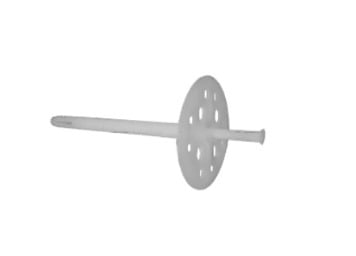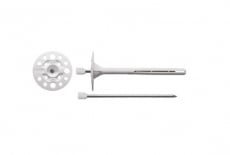Fasteners for thermal insulation are a group of fasteners that are designed to fix various insulating materials to the surface of the base. It is used for soft and hard heat-insulating materials. Such as mineral wool, glass wool, polystyrene, polyurethane, foam and many others to the base of concrete, light concrete, brick, as well as foam block.
Types and features of dowels for thermal insulation
Dowel-nail, often used as a fixator for insulating materials. It is a wide flat head that ensures reliable fixation of material and rods. The enlarged head is designed for even distribution of the load.
The set includes plastic or metal rods:
 |
 |
 |
|
Dowel for thermal insulation with a plastic nail
Has a lower probability of damaging the sheet for thermal insulation, does not transmit heat, does not suffer from corrosion. But the strength of this material is significantly lower. |
Dowel for thermal insulation with a metal nail
A metal nail is stronger, but it is more vulnerable to corrosion and often causes heat to escape.
|
Dowel for thermal insulation with a metal nail and thermal head They are considered a state-of-the-art solution. After all, they combine the advantages of dowels made of steel, because the rod is made of metal, but without the lack of heat conduction. |
How and where are fasteners for thermal insulation used?
Dowel for foam plastic (thermal insulation) is intended for mechanical fastening of thermal insulation to concrete and other bases. It has a thin head and is therefore perfect for fixing heat insulation in wet facades with thin plaster. This fastening element in facade systems does not allow heat-insulating plates to slide along the load-bearing wall. The plate dowel for insulation due to the increased contact area of the cap with heat insulation evenly distributes the load and is more reliably fixed.
Recommendations for installing a dowel for facade insulation
Fastening is carried out by means of through-mounting. At the same time, several factors should be taken into account:
- In order to create a reliable connection, you need to calculate the installation of the dowel so that it is not located directly at the joints of the sheets
- The head of the dowel should fit snugly against the heat-insulating material
- Fastening the thermal insulation with dowels may not cancel the installation with an adhesive composition, these two methods of fastening the thermal insulation sheets can be combined. In this case, the dowel insures against shifting and falling of the thermal insulation with increasing weight load.
What to pay attention to when choosing?
- The quality of the dowel, whether its head is deformed, such dowels cannot be used
- Вагу утеплювача - від цього залежатиме матеріал, з якого виготовлений цвях.
How to calculate the number of dowels and their length?
There should be at least 3-5 cm between the joint and the dowel.
- The depth of the hole should be 10 mm greater than the depth of the dowel installation.
- The number of dowels for installation is calculated based on the physical and chemical properties of the base for thermal insulation
- To avoid damage to the dowels, it is necessary to pre-drill holes approximately 2-3 mm larger than the length of the nail and clean them of foreign inclusions
- It is also worth calculating the length of the dowel correctly. If the spacer part of the dowel is equal to 80 mm, then it will be used only in hollow materials, such as aerated concrete, hollow brick and others. It is also worth considering the thickness of the insulation, for example, if it is equal to 100, then the dowel should be 180 mm long.
Advantages of dowels for fastening thermal insulation
- Dowels do not actually increase the weight of the structure, which is a strong advantage over wet installation.
- The mount is supplied immediately in the kit.
- High resistance to corrosion
- In terms of cost, these dowels are cheaper
- The disk head distributes the load in several vectors at once, which makes the use of such a fastener more profitable.
- Features of the design of the perforated cap of plate dowels allow it to merge with the surface of the base, which allows you to apply plaster over the heat-insulating material without any problems.


 Dowels (4)
Dowels (4)



